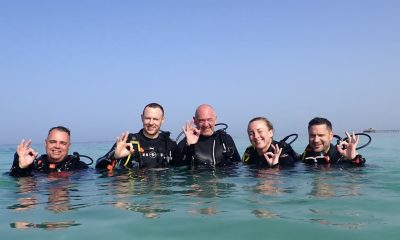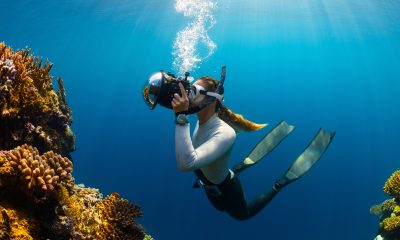News
SSI joins up with junior scientific dive team

Beginning in June 2016, SSI has teamed up with the Junior Scientific Dive Team and Looe Key Dive Center in the Florida Keys to promote the Marine Sciences to the next generation of students.
The Junior Scientific Dive Program was developed by Kama Cannon, a doctoral student at University of North Carolina, Wilmington. Kama came to the Florida Keys to create a dive program for young people between the ages of 10-15 that makes a direct connection between education and the real world with an emphasis on science, technology, engineering, and math.
 By combining the Next Generation Science Standards, Ocean Literacy Standards, and guidelines from the American Academy of Underwater Sciences (AAUS), Cannon developed a cross-curricular place-based Marine Science program that takes advantage of the local Florida Keys environment and resources.
By combining the Next Generation Science Standards, Ocean Literacy Standards, and guidelines from the American Academy of Underwater Sciences (AAUS), Cannon developed a cross-curricular place-based Marine Science program that takes advantage of the local Florida Keys environment and resources.
Cannon contacted Will Fox, General Manager and SSI Instructor Trainer/Certifier, of Looe Key Dive Center to coordinate the logistics of the program. Looe Key Dive Center committed by donating classroom, pool, boat space, and rental equipment, and SSI providing the Training Materials.
The program started with a full class of 16 students. “What we found is that we had a mix of students who weren’t reaching their full potential in school because either they weren’t challenged or didn’t see a practical need for what they were learning in school,” stated Cannon. “What is also exciting is that the class is predominantly female, especially girls from culturally diverse backgrounds, which are significantly under-represented in the math and science fields at all levels of school and industry. By emphasizing the scuba humanities and environmental science aspects, females were much more interested in the program.”
Since its inception, this program has exploded into something very special. Marcella, age 13, is about ready to complete her 50th dive. “The math we do here is real physics and math. The problems I solve here is what keeps me and my buddies alive. And we are all doing scientific research, not just reading about it. I am just finishing 8th grade and I just found out I won a four year scholarship to any Florida state school! I was not sure of what I wanted to focus on but now I’m interested in Marine Science.”
 All students are also continuing their diving education with SSI Specialty programs. As one of their goals, the group got to dive and map an actual ship wreck located in the Upper Keys, help MOTE Marine Lab with their Coral Bleach Watch program, and transplant baby corals with the Coral Restoration Foundation. Elizabeth, age 13, summed it up nicely – “That was the coolest thing I have ever done in my life!”
All students are also continuing their diving education with SSI Specialty programs. As one of their goals, the group got to dive and map an actual ship wreck located in the Upper Keys, help MOTE Marine Lab with their Coral Bleach Watch program, and transplant baby corals with the Coral Restoration Foundation. Elizabeth, age 13, summed it up nicely – “That was the coolest thing I have ever done in my life!”
Validating her initial concept, Cannon found that the real-world relevancy of what the kids were learning positively impacted their motivation both in the program and in science classes at school. “Despite being time consuming, academically challenging, and physically demanding, the actual projects that the group did were perceived as more meaningful than just regular school work. Scuba diving is challenging and the kids are challenged,” explained Cannon.
All of the Junior Scientific Divers are quite proud of their accomplishments and their ratings as both scuba divers with an emphasis on the scientific side. Cheyenne, age 13 explained: “I enjoy having the ability to constantly use my brain, to problem solve and work with science diving tools. Our learning is interactive. Another thing I love is that we perform procedures underwater that some people have trouble with on land!”
The environment is important to all of us and to reach out to the youth of today and engage them in the marine environment and sciences is truly exciting,” states Jeff Saenger, SSI Director of Sales. “We at SSI are committed to educating people on the aquatic environment and there is no better place to start or to invest in than the youth of today.”
Cannon further summed it up: “As an educator, it’s been very rewarding to see the growth in maturity, self-confidence, and academic motivation, especially in the girls. This is a program that could work anywhere.”
“It’s been a team effort between the group leaders, SSI, and Looe Key Dive Center and its staff. And it’s a lot of work sometimes, but also a lot of fun,” added Fox. “Overall, it’s a great program and everybody involved has benefited. We’re already gearing up for the 2017 group.”
For more information about this program, contact Kama Cannon +1 910-686-0399 – kamaleecannon@gmail.com or Looe Key Dive Center at +1 305-872-2215.
Blogs
Northern Red Sea Reefs and Wrecks Trip Report, Part 2: Wall to Wall Wrecks

Jake Davies boards Ghazala Explorer for an unforgettable Red Sea diving experience…
The second day’s diving was a day full of wreck diving at Abu Nuhas, which included the Chrisoula K, Carnatic, and Ghiannis D. The first dive of the day was onto the Chrisoula K, also known as the wreck of tiles. The 98m vessel remains largely intact where she was loaded with tiles which can be seen throughout the hold. The stern sits at 26m and the bow just below the surface. One of the highlights of the wreck is heading inside and seeing the workroom where the machinery used for cutting the tiles are perfectly intact. The bow provided some relaxing scenery as the bright sunlight highlighted the colours of the soft coral reef and the many reef fish.

Following breakfast, we then headed to the next wreck, which was the Carnatic. The Carnatic is an 89.9m sail steamer vessel that was built in Britain back in 1862. She ran aground on the reef back in 1869 and remains at 27m. At the time, she was carrying a range of items, including 40,000 sterling in gold. An impressive wreck where much of the superstructure remains, and the two large masts lay on the seafloor. The wooden ribs of the hull provide structures for lots of soft corals, and into the stern section, the light beams through, bouncing off the large shoals of glass fish that can be found using the structure as shelter from the larger predators that are found outside of the wreck.

The final wreck at Abu Nuhas was the Ghiannis D, originally called ‘Shoyo Maru,’ which was 99.5m long and built in Japan back in 1969 before becoming a Greek-registered cargo ship in 1980. The ship then ran aground on the reef on April 19th, 1983, and now sits at the bottom at a depth of 27m. Heading down the line, the stern of the ship remains in good condition compared to the rest of the hull. The highlight of the wreck, though, is heading into the stern section and down the flights of stairs to enter the engine room, which remains in good condition and is definitely worth exploring. After exploring the interior section of the ship, we then headed over to see the rest of the superstructure, where it’s particularly interesting to see the large table corals that have grown at the bow relatively quickly considering the date the ship sank. After surfacing and enjoying some afternoon snacks, we made sure everything was strapped down and secured as we would be heading north and crossing the Gulf of Suez, where the winds were still creating plenty of chop.

The next morning, it was a short hop to Ras Mohammed Nature Reserve for the next couple of days of diving. The 6am wake-up call came along with the briefing for the first site we would be diving, which was Shark & Yolanda. The low current conditions allowed us to start the dive at Anemone City, where we would drift along the steep, coral-filled wall. These dives involved drifts, as mooring in Ras Mohammed wasn’t allowed to protect the reefs. As a dive site, Shark & Yolanda is well-known and historically had a lot of sharks, but unfortunately not so many in recent years, especially not so early in the season. However, there was always a chance when looking out into the blue.

The gentle drift took us along the steep walls of the site, with plenty of anemone fish to be seen and a huge variety of corals. It wasn’t long into the dive before we were accompanied by a hawksbill turtle, who drifted with us between the two atolls before parting ways. Between the two reefs, the shallow patch with parts of coral heads surrounded by sand provided the chance to see a few blue-spotted stingrays that were mainly resting underneath the corals and are always a pleasure to see. With this being the morning dive, the early sunlight lit up the walls, providing tranquil moments. Looking out into the blue, there was very little to be seen, but a small shoal of batfish shimmering underneath the sunlight was a moment to capture as we watched them swim by as they watched us.

Towards the end of the dive, we stopped at the wreck of the Jolanda where the seafloor was scattered with toilets from the containers it was carrying. This provided a unique site to make a safety stop, which was also accompanied by a large barracuda slowly swimming by, along with a hawksbill turtle calmly swimming over the reef as the sun rays danced in the distance.
For the next dive, we headed north to the Strait of Tiran to explore the reefs situated between Tiran Island and Sharm El Sheik, which were named after the British divers who had found them. We started on Jackson before heading to Gordons Reef, where we also did the night dive. All the atolls at these sites provided stunning, bustling coral reefs close to the surface and steep walls to swim along, which always provided the opportunity to keep an eye out for some of the larger species that can be seen in the blue. Midwater around Jackson Reef was filled with red-toothed triggerfish and shoals of banner fish, which at times were so dense that you couldn’t see into the blue. Moments went by peacefully as we enjoyed the slow drift above the reef, watching these shoals swim around under the mid-afternoon sun.

The night dive at Gordon’s Reef was mainly among the stacks of corals surrounded by sand, which was great to explore under the darkness. After some time circling the corals, we came across what we were really hoping to find, and that was an octopus hunting on the reef. We spent the majority of the dive just watching it crawl among the reef, blending into its changing surroundings through changes in colour and skin texture. It’s always so fascinating and captivating to watch these incredibly intelligent animals, in awe of their ability to carry out these physical changes to perfectly blend into the reef. Before we knew it, it was time to head back to the boat to enjoy a well-deserved tasty dinner prepared by the talented chefs onboard.
Check in for the 3rd and final part of this series from Jake tomorrow!
To find out more about the Northern Red Sea reef and wrecks itineraries aboard Ghazala Explorer, or to book, contact Scuba Travel now:
Email: dive@scubatravel.com
Tel: +44 (0)1483 411590
Photos: Jake Davies / Avalon.Red
Marine Life & Conservation
Double Bubble for Basking Sharks

 The Shark Trust is excited to announce that, for two more days only, all donations, large or small, will be doubled in the Big Give Green Match Fund!
The Shark Trust is excited to announce that, for two more days only, all donations, large or small, will be doubled in the Big Give Green Match Fund!
Donate to Basking in Nature: Sighting Giants
The Shark Trust is hoping to raise £10k which will be doubled to £20k. This will go towards Basking in Nature: Sighting Giants. And they need YOUR help to reach they’re goal.
The Shark Trust’s citizen science project is to monitor and assess basking sharks through sightings; encouraging data collection, community engagement, and promoting nature accessibility. This initiative aims to enhance health and wellbeing by fostering a deeper connection with British Sharks.
Campaign Aims
- Increase citizen science reporting of Basking Sharks and other shark sightings to help inform shark and ray conservation.
- Provide educational talks about the diverse range of sharks and rays in British waters and accessible identification guides!
- Create engaging and fun information panels on how to ID the amazing sharks and rays we have on our doorstep! These can be used on coastal paths around the Southwest. With activities and information on how you can make a difference for sharks and rays!
- Promote mental wellbeing through increasing time in nature and discovering the wonders beneath the waves!
Donate, and double your impact. Click Here
-

 News3 months ago
News3 months agoHone your underwater photography skills with Alphamarine Photography at Red Sea Diving Safari in March
-

 News3 months ago
News3 months agoCapturing Critters in Lembeh Underwater Photography Workshop 2024: Event Roundup
-

 Marine Life & Conservation Blogs2 months ago
Marine Life & Conservation Blogs2 months agoCreature Feature: Swell Sharks
-

 Blogs2 months ago
Blogs2 months agoMurex Resorts: Passport to Paradise!
-

 Blogs2 months ago
Blogs2 months agoDiver Discovering Whale Skeletons Beneath Ice Judged World’s Best Underwater Photograph
-

 Gear Reviews2 months ago
Gear Reviews2 months agoGear Review: Oceanic+ Dive Housing for iPhone
-

 Marine Life & Conservation2 months ago
Marine Life & Conservation2 months agoSave the Manatee Club launches brand new webcams at Silver Springs State Park, Florida
-

 News3 months ago
News3 months agoWorld’s Best Underwater Photographers Unveil Breathtaking Images at World Shootout 2023















